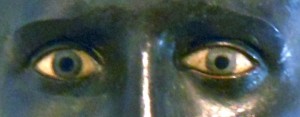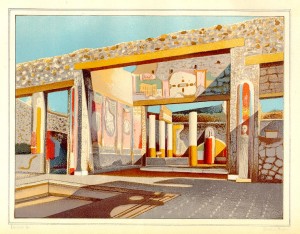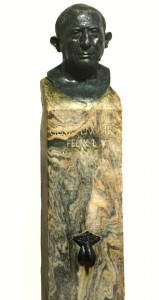 by Caroline Lawrence (Wonders and Marvels contributor)
by Caroline Lawrence (Wonders and Marvels contributor)Students and teachers familiar with the Cambridge Latin Course were in for a shock at the British Museum Pompeii exhibition this summer. We saw Lucius Caecilius Iucundus as never before and many of us exclaimed Herclé! (By Hercules!)
Everybody knows his face from the famous orange textbook 1. His first appearance in the garden is now a meme – Caecilius est in horto – and he has even met Dr. Who. Using delightful line drawings and deceptively simple stories, the clever authors lull us into a false sense of security until the story ends in tears with < Spoiler Alert!> Caecilius’ moving death during the eruption of Vesuvius. The faithful slave Clemens finds his dying master under a partly collapsed wall. Clemens wants to stay, but Caecilius tells him to make sure his son and wife survive. “Clemens, abi!” he gasps. (“Clemens, go!”) Then he dies with the faithful watchdog Cerberus refusing to leave his master’s body. *Sob!*
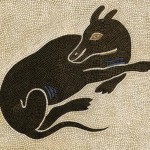 The Cambridge Classics School Project textbook informs us that a bronze portrait bust of Caecilius was found in his house in Pompeii, along with a dog mosaic: one of about half a dozen examples that have survived from the ancient world. There were also lots of wax tablets showing us that he was an argentarius, a cross between a banker and auctioneer. Today we would call him an entrepreneur.
The Cambridge Classics School Project textbook informs us that a bronze portrait bust of Caecilius was found in his house in Pompeii, along with a dog mosaic: one of about half a dozen examples that have survived from the ancient world. There were also lots of wax tablets showing us that he was an argentarius, a cross between a banker and auctioneer. Today we would call him an entrepreneur.
What the book doesn’t tell us is that wax tablets and other records bearing his seal cease a few days before the big earthquake of AD 62, leading many scholars to believe that Caecilius died in that earthquake, 17 years before the infamous eruption. There is also a famous relief of the earthquake in the lararium of the townhouse that he (presumably) left to his children.
Caecilius’s ugly-yet-loveable mug appears throughout the book and when you enter the atrium of the British Museum’s exhibit you first get a thrill of recognition, and then a shock when you see how the artist really has depicted him warts and all. But a bigger shock awaits as you lower your gaze and see that Caecilius’s head is part of a herm, a rectangular plinth with a head on top and male genitalia half way down the front. Sure enough, there is Caecilius’ willy! Edepol! (Pollux!) They never let on about that in the Cambridge Latin Course!
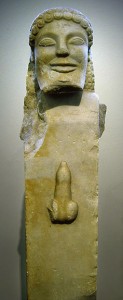 So what on earth is going on? Is someone playing a nasty practical joke on our beloved banker?
So what on earth is going on? Is someone playing a nasty practical joke on our beloved banker?
As ever, the answer lies in the fact that the Romans are like us, and yet not like us. I keep blogging about how superstitious the Romans were and Evil Eyes and such things, and this herm of Caecilius is a perfect example.
Nobody is exactly sure what a herm is or how they originated. The best theory is that they started as piles of rocks at crossroads or boundaries, always dodgy places in ancient Rome. Later this pile-o-rocks was superseded by a wooden or stone plinth topped with the head of a god and with the genitals about midway down. The penis (usually erect but sometimes flaccid) was a very common apotropaic device, to turn away evil. It represents the animal nature or power of a man. It also has an “eye”. As the poet Martial says of the male member: sit lusca licet, te tamen illa videt. (“Although it has only one eye, it’s looking at you!” Martial IX.37).
But a herm is doubly apotropaic because a staring face is another very powerful means of frightening away evil and/or evil doers. You can see the place where glass paste or a gemstone would have given Caecilius realistically staring eyes. Remember the recent story about how bike thefts in Newcastle went right down when this sign was put up?
In effect, herms were like ancient scarecrows that kept away trespassers, thieves and bad luck.
The oldest recognisable herms are from the Archaic period. The head on top is usually that of Hermes, Dionysus or Hercules, all deities of fertility or power. (The name Hermes probably comes from the Greek word herma which means “a stone set up”.) Herms changed appearance as sculpture evolved. You may remember the story of how a volatile young statesman named Alcibiades (allegedly) defaced the herms of Classical Athens.
Later, in Hellenistic times, Greeks started to put the heads of ephebes (high born youths) on the herms. Again we’re not sure exactly why, only that these herms adorned and protected the gymnasium where these young men worked out.
 By Cicero’s time (1st century BC) intellectual Romans thought it would be fun to put realistic portraits on herms. We have a roomful of examples from the opulent House of the Papyri near Herculaneum (template for the marvellous Getty Villa in Malibu). This house was famously owned by a man who followed the Epicurean philosophy.
By Cicero’s time (1st century BC) intellectual Romans thought it would be fun to put realistic portraits on herms. We have a roomful of examples from the opulent House of the Papyri near Herculaneum (template for the marvellous Getty Villa in Malibu). This house was famously owned by a man who followed the Epicurean philosophy.
The Greek ideal of beauty was a small penis, whereas the Romans thought the bigger the better when it came to turning away evil. The fact that Caecilius’ member is small and limp hints at possible connections with Greece. Perhaps, like many higher-born Romans, he studied rhetoric in Athens. The modest, stylised, almost apologetic willy does not really match the portrait bust above it, which as I have said is literally warts and all. (In a recent lecture at the British Museum, curator Paul Roberts commented that the face is as close as possible to the man’s to give the spirit of him.)
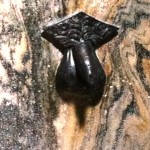 The herm was not set up by Caecilius himself, but by one of his freedmen, and possibly after his death. It is dedicated to the “genius” or spirit of Caecilius: GENIO L[UCII] NOSTRI FELIX L[IBERTUS] “To the Genius of our Lucius. I, Felix, his freedman [commissioned it]” It was probably a kind of ancestor statue, designed to be worshipped along with the other household gods. But it also served another function. With face and phallus facing the front door, the herm averted evil and protected not only the contents and inhabitants of the house, but perhaps also his entire legacy.
The herm was not set up by Caecilius himself, but by one of his freedmen, and possibly after his death. It is dedicated to the “genius” or spirit of Caecilius: GENIO L[UCII] NOSTRI FELIX L[IBERTUS] “To the Genius of our Lucius. I, Felix, his freedman [commissioned it]” It was probably a kind of ancestor statue, designed to be worshipped along with the other household gods. But it also served another function. With face and phallus facing the front door, the herm averted evil and protected not only the contents and inhabitants of the house, but perhaps also his entire legacy.
Just as we find the contrast of his realistic face and coy genitals incongruous, so the Romans might have had a chuckle upon first seeing it. But laughter is another apotropaic device. So this herm is triply apotropaic while still hinting at the founder’s wit and erudition. (below: antique print shows the possible original location of Caecilius’ herm at the back of the atrium and just before the tablinum, facing the front door.)
This herm of Caecilius serves to remind us how pervasive was the daily threat of random calamity and how charmingly the Romans addressed it. Ironically, it also underlines how ineffectual all their charms, offerings and prayers were against the power of Vesuvius.
For a clearly-written article on the apotropaic nature of the penis, read Claudia Moser’s delightful undergraduate thesis, Naked Power. It will tell you everything you wanted to know about the apotropaic phallus but were afraid to ask.
To introduce children to the concept, buy them The Colossus of Rhodes, which has winged willies on the very first page. But all in the best possible taste.


